Since The Dawn of Humanity, Foods Have Been Used as Medicine.
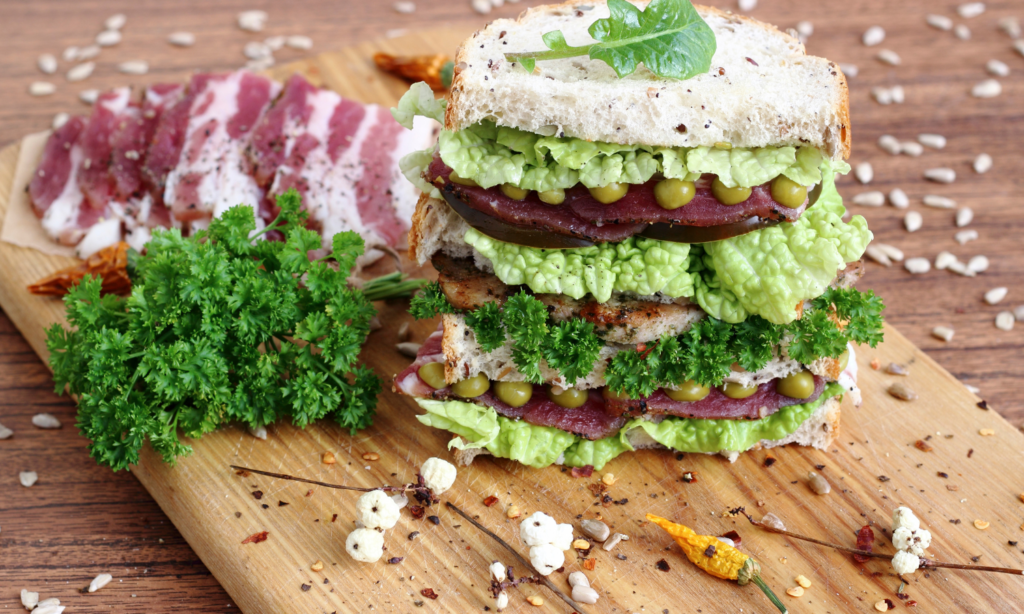
The truth is that healthy foods are medicine, and this ancient wisdom is now backed by modern science.

But how exactly does this work in the body, and what are the specific mechanisms that make food such a powerful tool for healing?
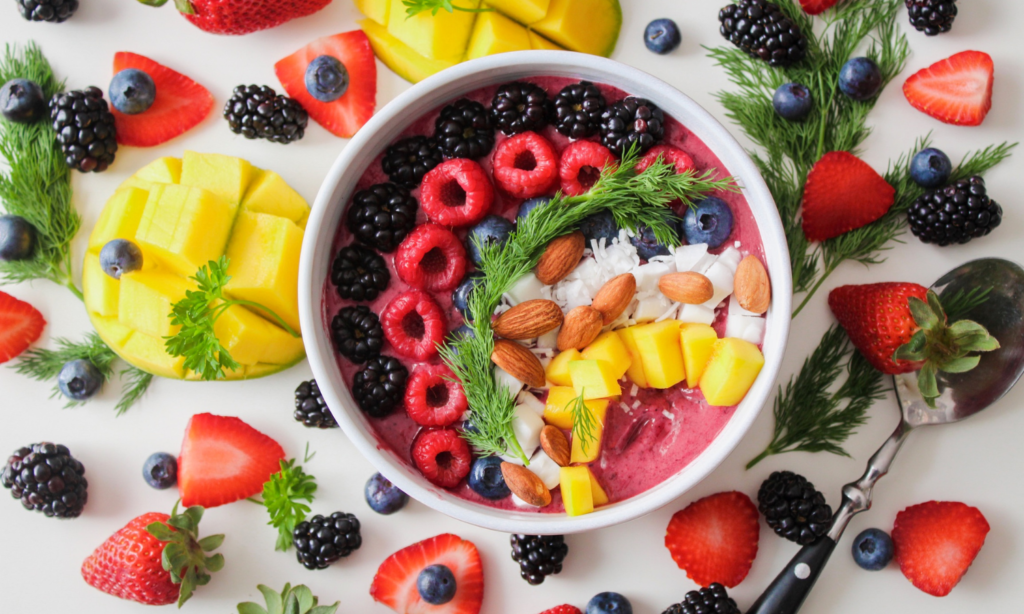
Why aren’t more people harnessing the power of food to transform their health?
Healthy Foods Are Nature's Medicine
Imagine a world where your kitchen doubles as a pharmacy, where the vibrant colors of fruits and vegetables are not just a feast for your eyes but a prescription for vitality.
Picture a life where every bite you take is a step toward healing, energy, and longevity.
Sounds too good to be true? It’s not.
The truth is that healthy foods are medicine, and this ancient wisdom is now backed by modern science. But how exactly does this work? And why aren’t more people harnessing the power of food to transform their health?
Buckle up, because this article will take you on a journey through the fascinating connection between nutrition and well-being, and by the end, you’ll see your plate in a whole new light.
The Ancient Wisdom: Food as Healing
Long before the advent of modern medicine, civilizations around the world understood the medicinal power of food.
Traditional Chinese Medicine (TCM) has used food as a cornerstone of healing for thousands of years, prescribing specific foods to balance the body’s energy, or
*qi*. Similarly, Ayurveda.
The ancient Indian system of medicine classifies foods based on their healing properties and their ability to balance the body’s doshas (energies). Even Hippocrates, the father of Western medicine, famously said,
*“Let food be thy medicine and medicine be thy food.”*
But this isn’t just ancient history. Modern science is now catching up to what these traditions have known all along: the foods we eat have a profound impact on our health, influencing everything from our immune system to our mental well-being.
The Science Behind Food as Medicine
So, how does food work as medicine? The answer lies in the complex interplay of nutrients, antioxidants, and bioactive compounds found in whole, unprocessed foods. Let’s break it down:
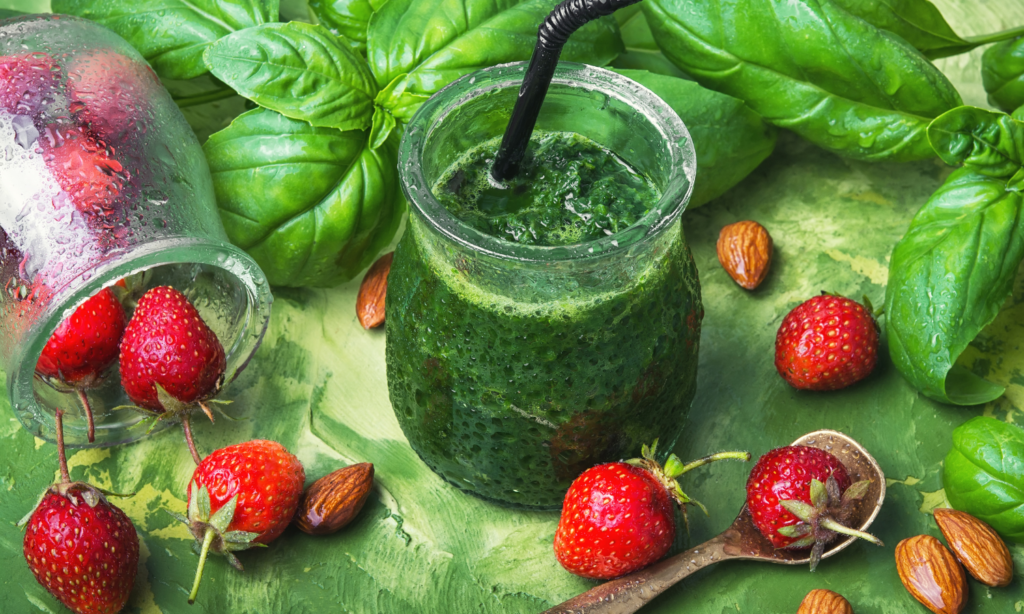
Fresh Spinach Smoothies
🥬 Fresh Spinach Smoothie Recipe
Ingredients:
1 cup fresh spinach leaves (packed) 1 banana (adds natural sweetness) 1/2 apple or 1/2 cup pineapple chunks (for a fruity balance 1/2 avocado (optional – for creaminess and healthy fats) 1 cup coconut water (or almond milk) 1 tbsp lemon juice (adds brightness and balances flavor) 1 tsp honey or agave (optional) 1/2 cup ice (optional)
Instructions:
Start by adding the spinach, banana, and fruit to the blender. Add the avocado (if using), coconut water, and lemon juice.
Sweeten with honey or agave if desired.
Toss in ice cubes for a refreshing chill. Blend until completely smooth and vibrant green.
Serve immediately—best enjoyed fresh!
Tip: Add a small piece of fresh ginger for a zesty kick and extra health benefits.
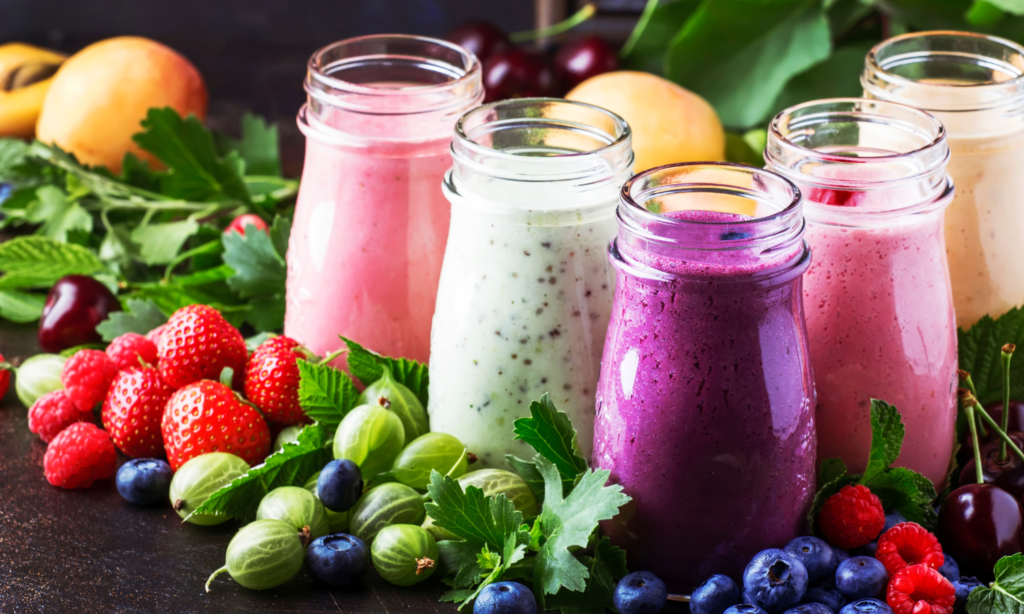
Berry Fruit Smoothies
🍓 Berry Fruit Smoothie Recipe
Ingredients:
1 cup mixed berries (strawberries, blueberries, raspberries, blackberries – fresh or frozen)
1 banana (for natural sweetness and creaminess)
1/2 cup Greek yogurt (or any plain yogurt)
1/2 cup orange juice (or apple juice)
1/2 cup almond milk (or regular milk, or any plant-based milk)
1 tbsp honey or maple syrup (optional, depending on sweetness)
1/2 cup ice (optional, especially if using fresh fruit)
Instructions:
-
Add the mixed berries, banana, and yogurt to your blender. Pour in the orange juice and almond milk. Add honey or maple syrup if you’d like a little extra sweetness.
Toss in the ice (if using) for a frosty texture. Blend on high until smooth and creamy. Pour into a glass and enjoy right away!
Tip: You can sprinkle chia seeds or flaxseeds on top for added fiber and omega-3s.
1. **Nutrients as Building Blocks**: Every cell in your body relies on nutrients like vitamins, minerals, proteins, fats, and carbohydrates to function properly.
For example, whole vegetable smoothies contain enough vitamin C to boost your immune system, calcium strengthens your bones, and omega-3 fatty acids support brain health.
When you eat nutrient-dense foods, you’re essentially giving your body the tools it needs to repair, grow, and thrive.
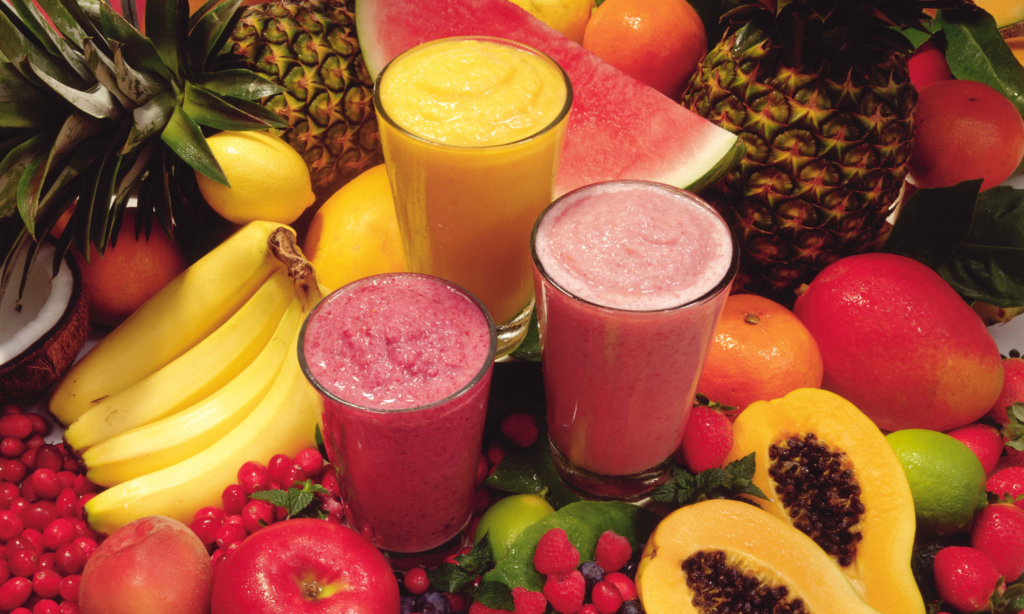
Tropical Fruit Smoothie
🥭 Tropical Fruit Smoothie Recipe
Ingredients:
1/2 cup mango chunks (fresh or frozen), 1/2 cup pineapple chunks (fresh or frozen), 1/2 banana (for creaminess) 1/2 cup orange juice (or coconut water for extra tropical vibes) 1/2 cup Greek yogurt (or coconut yogurt for a dairy-free option) 1/4 cup shredded coconut (optional, for more tropical flavor) 1/2 cup ice (optional, especially if using fresh fruit) 1 tbsp honey or agave (optional, depending on sweetness)
Instructions:
Add mango, pineapple, and banana to your blender. Pour in the orange juice and yogurt. Sprinkle in the shredded coconut if using. Add ice and sweetener if needed. Blend on high until smooth and creamy. Pour into a glass and garnish with a pineapple slice or a sprinkle of coconut if you’re feeling fancy.
Tip: Add a splash of lime juice for a tangy twist, or toss in a handful of spinach to sneak in some greens without affecting the tropical flavor too much.
😉ENJOY YOUR SMOOTHIE🥲
2. **Antioxidants as Protectors**: Many fruits and vegetables are rich in antioxidants, which combat oxidative stress, a major contributor to chronic diseases like heart disease, cancer, and diabetes.
Blueberries, spinach, and kale, for instance, are packed with antioxidants that help neutralize harmful free radicals in your body.

Tropical Smoothie Bowl
Smoothie Base Ingredients:
1/2 cup frozen mango chunks, 1/2 cup frozen pineapple chunks /2 frozen bananas (for that creamy texture), 1/4 cup coconut milk (or almond milk—just enough to blend), 1/4 cup Greek yogurt or coconut yogurt 1 tbsp shredded coconut (optional), Splash of lime juice (optional for brightness). Note: Use frozen fruit to keep the texture thick and scoopable.
Instructions:
Add frozen mango, pineapple, banana, yogurt, and coconut milk to a blender. Blend until smooth and thick, like soft-serve ice cream. Add a splash more liquid only if needed. Spoon the smoothie into a bowl.
Topping Ideas:
Fresh pineapple or mango slices, sliced banana, Shredded coconut, and Granola (for crunch!) Chia seeds or flaxseeds, A drizzle of honey or nut butter, Edible flowers or mint leaves (for that extra tropical look) Pro Tip: Chill your bowl in the freezer for 10 minutes before pouring in the smoothie—it keeps everything cold longer and feels like a mini spa treat.😎
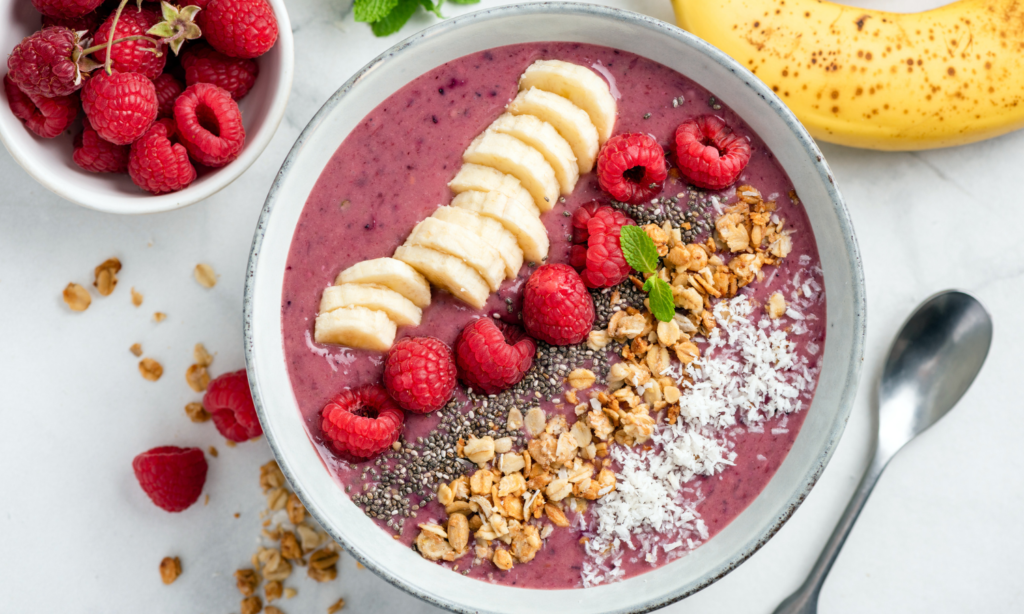
Protein-Packed Tropical Smoothie Bowl
Smoothie Base Ingredients:
1/2 cup frozen mango 1/2 cup frozen pineapple 1/2 frozen banana
1 scoop vanilla protein powder (whey or plant-based)
1/4 cup Greek yogurt (or high-protein alternative yogurt
1/3 cup coconut water or almond milk
1 tbsp chia seeds or flaxseeds (extra fiber + omegas)
1 tbsp nut butter (like almond or cashew – optional but creamy & rich)
Instructions:
Blend everything until thick and creamy, adding just enough liquid to keep it scoopable. Pour into a chilled bowl. Topping Ideas: Sliced banana, Granola or high-protein cereal, Hemp hearts, or chia seeds. A drizzle of peanut or almond butter. A few almonds, cashews, or walnuts for crunch
3. **Bioactive Compounds as Healers**: Beyond basic nutrients, foods contain bioactive compounds that have specific healing properties.
Turmeric, for example, contains curcumin, a powerful anti-inflammatory compound.
Garlic contains allicin, which has been shown to lower blood pressure and cholesterol.
These compounds work like natural pharmaceuticals, targeting specific health issues without the side effects of synthetic drugs.
The Gut-Brain Connection:
Food for Thought: One of the most exciting areas of research in recent years is the gut-brain connection. Did you know that your gut is often referred to as your “second brain”?
This is because your gut and brain are in constant communication through the gut-brain axis. The foods you eat directly influence the health of your gut microbiome—the trillions of bacteria living in your digestive system. A healthy gut microbiome not only supports digestion but also plays a crucial role in mental health, immunity, and even weight management.
For example, fermented foods like yogurt, kefir, and sauerkraut are rich in probiotics, which promote a healthy gut microbiome. On the other hand, a diet high in processed foods and sugar can disrupt this delicate balance, leading to inflammation and a host of health problems. By choosing the right foods, you can nourish your gut and, in turn, support your overall well-being.
Real-Life Examples:
Food as Medicine in Action. Still skeptical? Let’s look at some real-life examples of how food can act as medicine:
**Heart Health**: The Mediterranean diet, rich in olive oil, nuts, fish, and whole grains, has been shown to reduce the risk of heart disease by up to 30%. This is because these foods are high in heart-healthy fats, fiber, and antioxidants.

Greek Chickpea Salad
Ingredients:
1 can of chickpeas (drained and rinsed) 1 cucumber (diced), 1 cup cherry tomatoes (halved), ¼ red onion (thinly sliced), ¼ cup Kalamata olives (pitted, halved), ¼ cup crumbled feta cheese 2 tbsp olive oil,1 tbsp red wine vinegar, 1 tsp dried oregano (Salt to taste)
Steps:
Combine chickpeas, cucumber, tomatoes, onion, and olives in a bowl. In a small bowl, whisk olive oil, vinegar, oregano, and salt. Pour dressing over the salad. Toss gently, top with feta, and serve chilled or at room temperature.
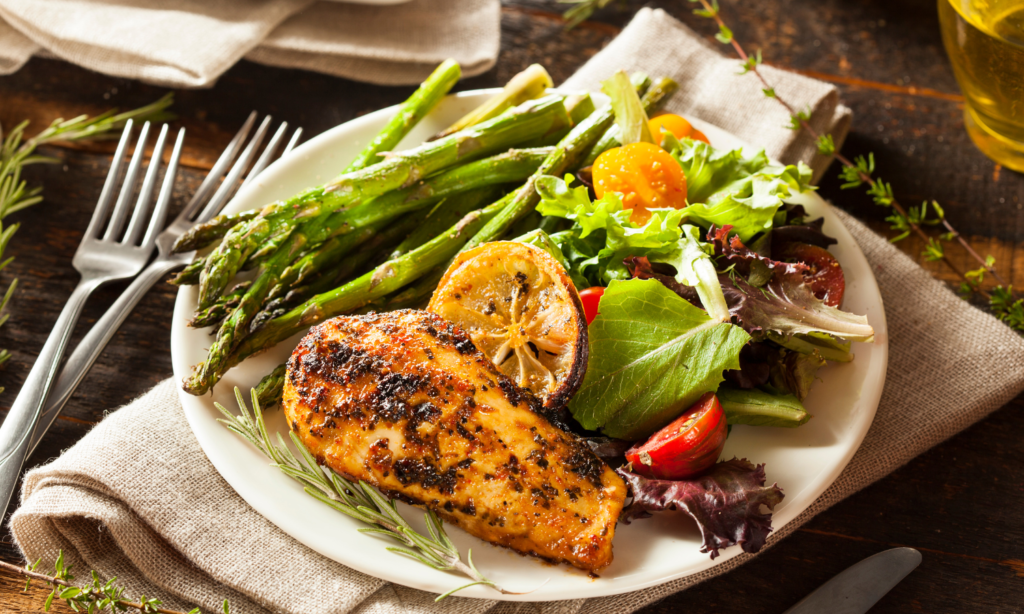
Grilled Lemon Herb Chicken
Ingredients:
2 boneless chicken breasts, Juice of 1 lemon, 2 tbsp olive oil, 2 cloves garlic (minced), 1 tsp dried oregano, Salt and pepper to taste (Fresh parsley optional) for garnish)
Steps:
In a bowl, mix lemon juice, olive oil, garlic, oregano, salt, and pepper. Marinate chicken for at least 30 minutes. Preheat grill or skillet over medium-high heat. Cook chicken 5–6 minutes per side or until done.
Garnish with chopped parsley if desired.
**Diabetes Management**: A diet high in fiber-rich foods like beans, lentils, and vegetables can help regulate blood sugar levels, making it a powerful tool for managing and even preventing type 2 diabetes.
**Mental Health**: Studies have found that diets rich in fruits, vegetables, whole grains, and lean proteins are associated with a lower risk of depression and anxiety. On the flip side, diets high in processed foods and sugar are linked to an increased risk of mental health issues.
Why Aren’t More People Using Food as Medicine?
Given the overwhelming evidence, why aren’t more people embracing food as medicine? The answer lies in a combination of factors:
1. **Lack of Education**: Many people simply aren’t aware of the healing power of food. Nutrition education is often lacking in schools and medical training, leaving people to rely on quick fixes like pills and fad diets.
2. **Convenience Culture**: In today’s fast-paced world, processed and fast foods are often more convenient than cooking a nutritious meal from scratch. However, this convenience comes at a cost to our health.
3.**Misinformation**: The food industry is flooded with conflicting messages, from fad diets to misleading food labels. This can make it difficult for people to discern what truly constitutes healthy eating.
How to Harness the Power of Food as Medicine:
Ready to start using food as medicine? Here are some practical tips to get you started:
1. **Eat the Rainbow**: Aim to include a variety of colorful fruits and vegetables in your diet. Each color represents different nutrients and antioxidants, so the more variety, the better.
2. **Choose Whole Foods**: Opt for whole, unprocessed foods whenever possible. This means choosing brown rice over white rice, whole fruits over fruit juice, and fresh vegetables over canned ones.
3. **Incorporate Healing Herbs and Spices**: Add turmeric, ginger, garlic, and cinnamon to your meals for an extra boost of healing compounds.
4. **Listen to Your Body**: Pay attention to how different foods make you feel. If a certain food leaves you feeling sluggish or bloated, it might not be the best choice for you.
5. **Cook at Home**: Cooking your own meals allows you to control the ingredients and avoid hidden sugars, unhealthy fats, and additives.
The Future of Food as Medicine
As the field of nutrition science continues to evolve, the concept of food as medicine is gaining traction. Functional medicine, a growing field that focuses on addressing the root causes of disease, places a strong emphasis on diet and lifestyle changes. Hospitals and clinics are beginning to incorporate nutrition counseling and even “food pharmacies” into their treatment plans.
But you don’t have to wait for the healthcare system to catch up. You can start using food as medicine today, right in your own kitchen. By making mindful choices about what you eat, you have the power to prevent disease, boost your energy, and enhance your quality of life.
Conclusion: Your Plate, Your Power!
The next time you sit down to eat, remember that your plate is more than just a meal—it’s an opportunity to nourish your body, heal your mind, and transform your health
Healthy foods are indeed medicine, and they’re some of the most powerful tools we have for preventing and reversing disease. So, why not start today? Your body—and your future self—will thank you.
Did this article change the way you think about food? Share it with someone who could benefit from this knowledge, and let’s spread the word: healthy foods are medicine, and the power to heal is on your plate.
Menu

